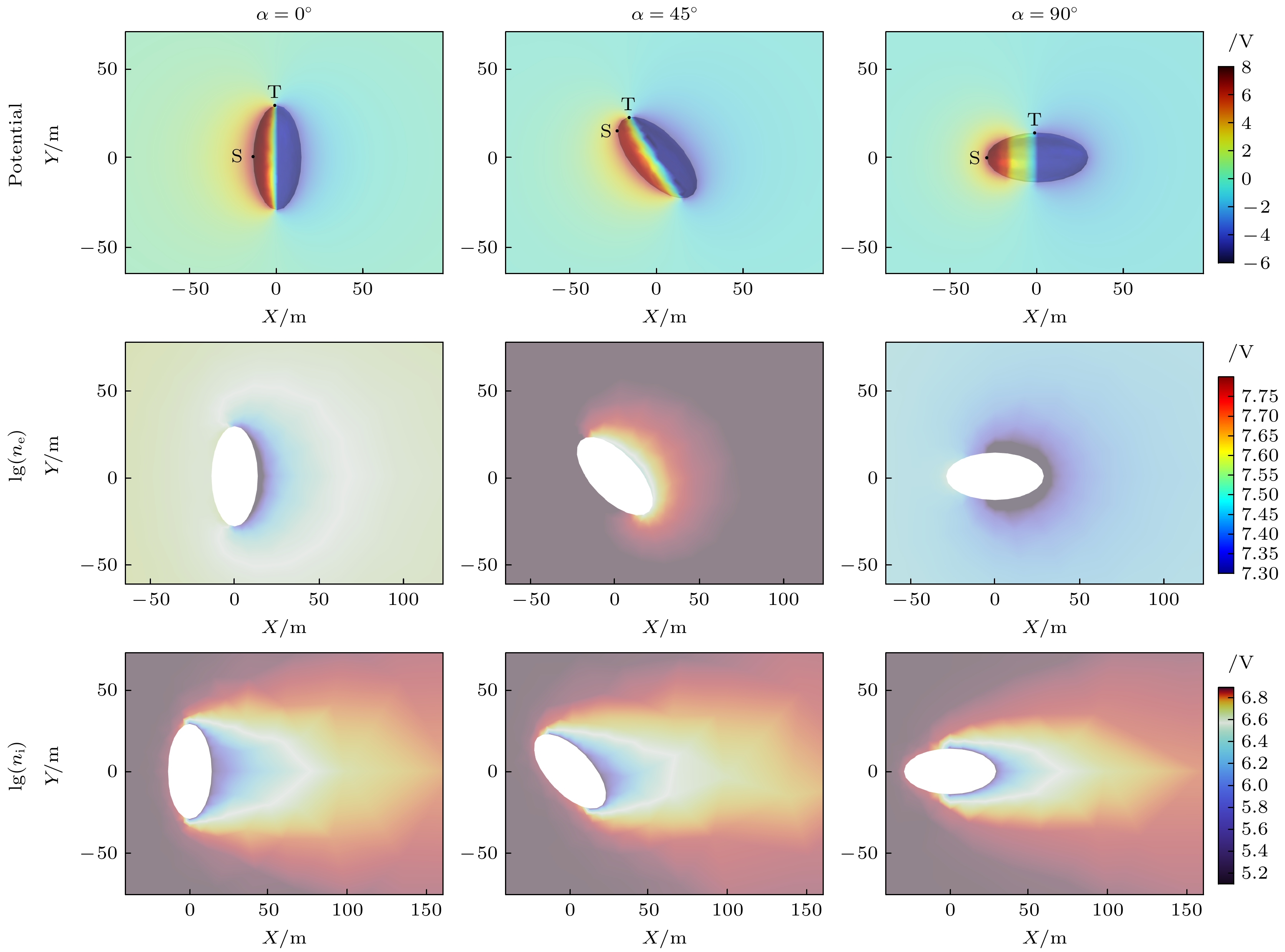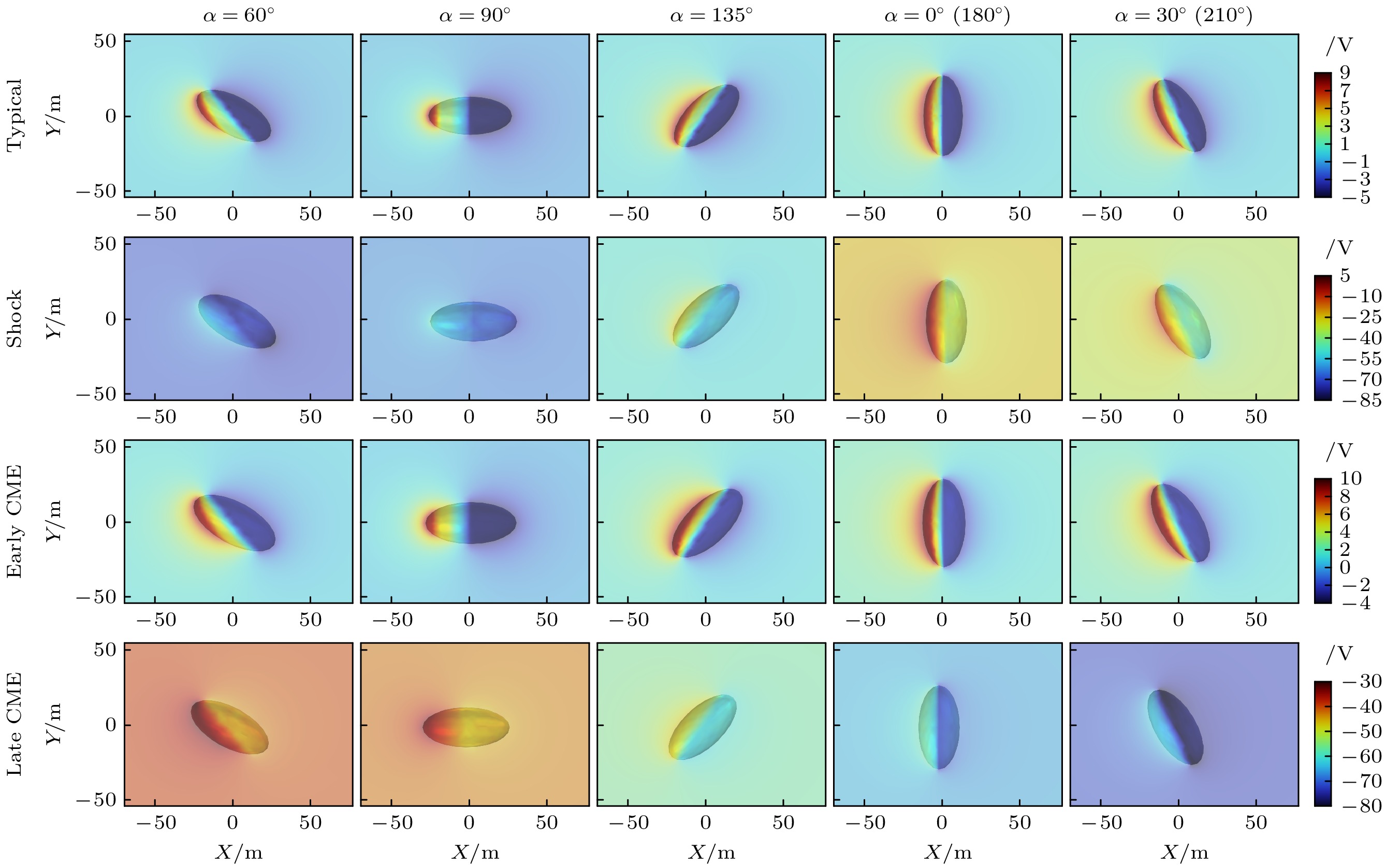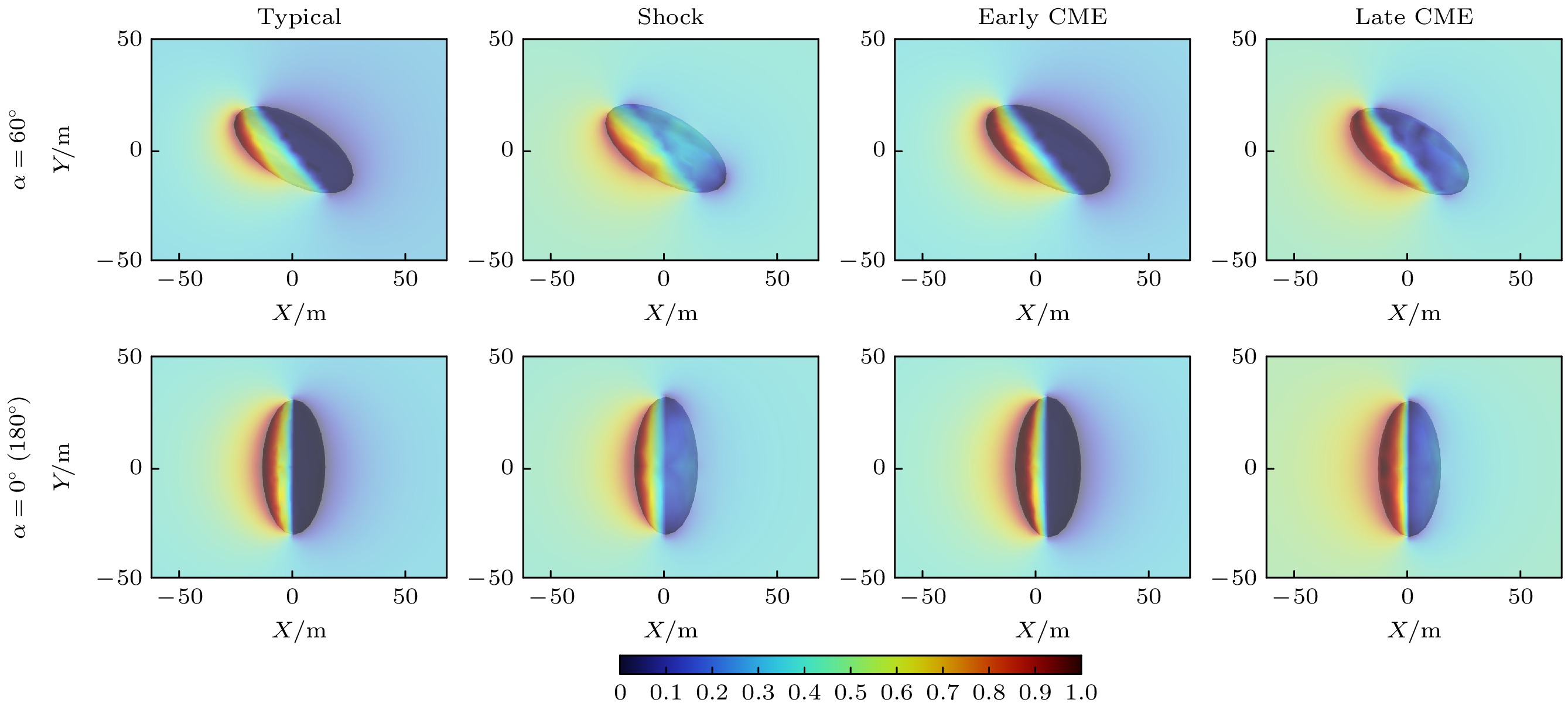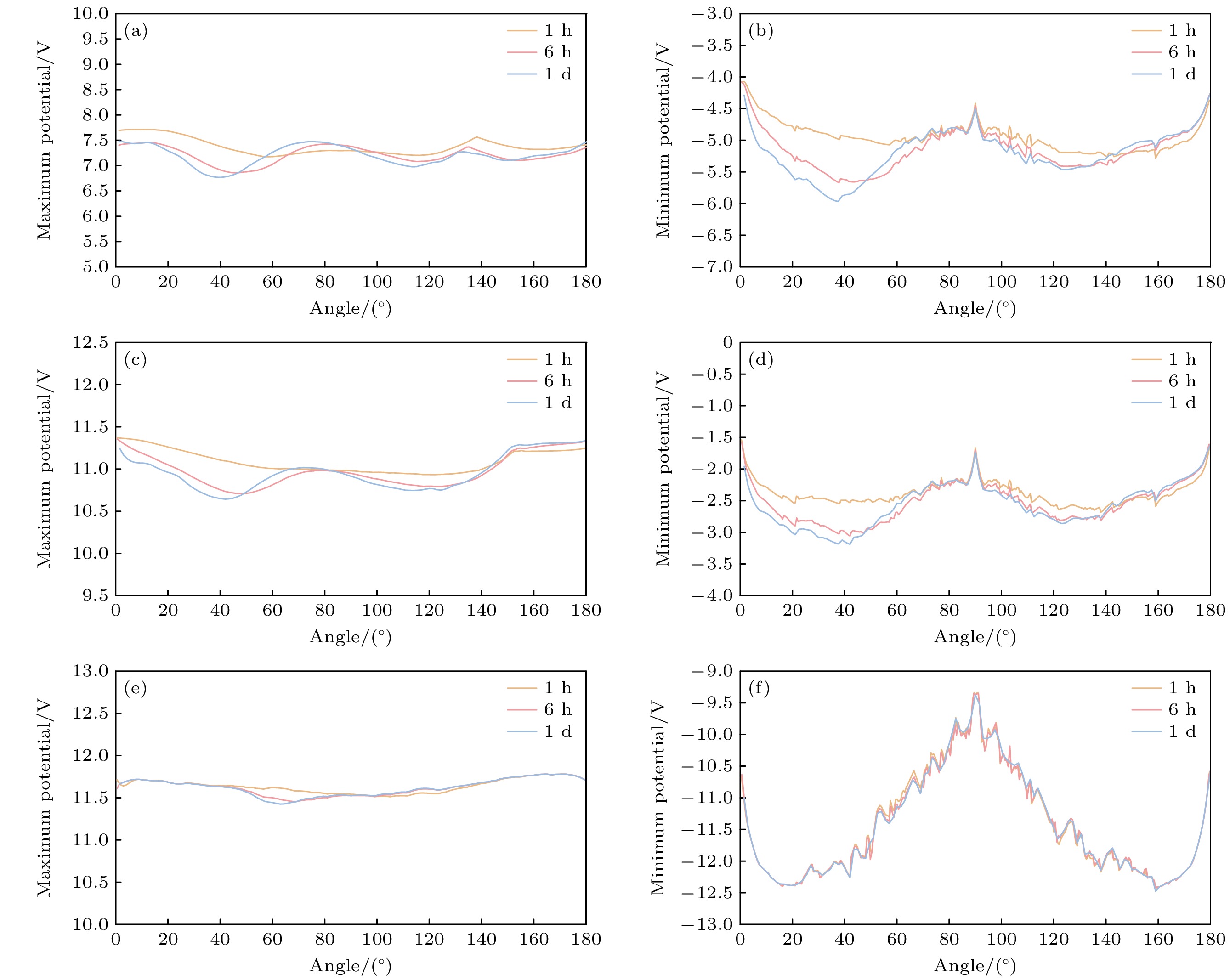-
空间等离子体环境中的带电粒子附着和运动会在小行星表面形成可观测的电位, 这一表面充电现象阻碍了小行星的安全着陆和探索. 传统方法计算速度较低, 且聚焦于静态小行星, 缺少对实际情况中旋转小行星的充电机制研究. 为此, 本文提出了基于神经网络和有限元法的多尺度模型, 实现了对旋转小行星的三维动态模拟. 对小行星和周围环境的模拟和分析结果表明, 小行星表面的最大和最小电位均会随着自转周期增长而减小, 夜侧最小电位由周期为1 h的–4.96 V降低为周期为七天的–5.97 V, 当周期长于七天时, 这种下降趋势变缓, 七天到半年的周期增长仅能造成0.001 V的电位变化. 太阳风暴经过期间, 电子和离子的密度及温度升高, 自转周期导致的电位差异可达上百伏. 表面材料的组成也会影响小行星表面电位受周期影响的差异程度. 由斜长石或斜方辉石构成时, 不同自转周期小行星之间的表面电位差异较为明显, 而钛铁矿构成的小行星则更依赖于所处姿态. 研究自转小行星的表面充电现象, 对探究小行星与太阳风相互作用的性质至关重要.The attachment and movement of charged particles in the space plasma environment can result in observable potentials on the asteroid surface. This surface charging phenomenon has been extensively studied. However, so far, the influence of asteroid rotation on surface charging and the surrounding plasma has not yet been fully understood. Traditional methods using numerical integration and PIC have slow computation speeds, and mainly focus on the charging mechanisms of static asteroids. In this study, we establish a multi-scale model based on neural networks and the finite element method, thereby improving simulation efficiency and enabling three-dimensional dynamic simulations of rotating asteroids. Simulation results for asteroids with different rotation periods indicate that both the maximum surface potential and the minimum surface potential decrease as the rotation period increases. The minimum potential on the nightside decreases from –4.96 V with one-hour period to –5.97 V with one-week period. For asteroids with longer periods, this downward trend slows down: the period increases from one week to half a year, resulting in a potential change of 0.001 V. Because strong electric field near the the terminator accelerates electrons and ions, electrons respond more promptly to the electric field, owing to their much higher mobility and diffusion coefficient, exhibiting a more severe accumulation phenomenon than ions, resulting in the decrease of the surface potential. This phenomenon is most pronounced when the solar wind is obliquely incident, where the subsolar point is close to the terminator, resulting in the strongest electric field. When the period exceeds one week, this downward trend becomes less pronounced, specifically, the asteroid and plasma have enough time to reach equilibrium at various angles. During the passage of solar storms, there is a significant change in surface potential at different stages, with potential difference caused by rotation periods reaching hundreds of volts. Surface minerals also play a role, with plagioclase being the most sensitive mineral in the exploration, while ilmenite seems indifferent to changes in rotation periods. Understanding the surface charging of asteroids under various rotation periods and angles is crucial for further studying the solar wind plasma and the motion of asteroid’s surface dust, providing a reference for achieving safe landing and exploration of asteroids.
-
Keywords:
- asteroids /
- solar wind plasma /
- neural networks /
- surface charing
[1] Zimmerman M I, Farrell W M, Hartzell C M, Wang X, Horanyi M, Hurley D M, Hibbitts K 2016 J. Geophys. Res.: Planets 121 2150
 Google Scholar
Google Scholar
[2] Hartzell C M, Scheeres D J 2013 J. Geophys. Res.: Planets 118 116
 Google Scholar
Google Scholar
[3] Xie L H, Li L, Wang J D, Zhang Y T, Zhou B, Feng Y Y 2023 Astrophys. J. 952 61
 Google Scholar
Google Scholar
[4] Stubbs T J, Farrell W M, Halekas J S, Burchill J K, Collier M R, Zimmerman M I, Vondrak R R, Delory G T, Pfaff R F 2014 Planet. Space Sci. 90 10
 Google Scholar
Google Scholar
[5] Kureshi R, Tripathi K R, Mishra S K 2020 Astrophys. Space Sci. 365 23
 Google Scholar
Google Scholar
[6] Halekas J S, Delory G T, Brain D A, Lin R P, Fillingim M O, Lee C O, Mewaldt R A, Stubbs T J, Farrell W M, Hudson M K 2007 Geophys. Res. Lett. 34 L02111
 Google Scholar
Google Scholar
[7] Halekas J S, Delory G T, Lin R P, Stubbs T J, Farrell W M 2009 J. Geophys. Res.: Space Phys. 114 A5
 Google Scholar
Google Scholar
[8] Zimmerman M I, Farrell W M, Poppe A R 2014 Icarus 238 77
 Google Scholar
Google Scholar
[9] Quan R H, Zhang C Y, Zhang H C 2023 IEEE Trans. Plasma Sci. 51 1181
 Google Scholar
Google Scholar
[10] Zhu H H, Cui Z Q, Liu J, Jiang S H, Liu X, Wang J H 2023 J. Mar. Sci. Eng. 11 1340
 Google Scholar
Google Scholar
[11] Liu H, Xu Y, Wang C Y, Ding F, Xiao H S 2022 Mater. Res. Express 9 025504
 Google Scholar
Google Scholar
[12] Adil M, Ullah R, Noor S, Gohar N 2022 Neural Comput. Appl. 34 8355
 Google Scholar
Google Scholar
[13] Qian H M, Zhang H, Huang T, Huang H Z, Wang K 2023 Qual. Reliab. Eng. Int. 39 1878
 Google Scholar
Google Scholar
[14] 王馨悦, 张爱兵, 荆涛, Reme H, 孔令高, 张珅毅, 李春来 2016 地球 59 3533
 Google Scholar
Google Scholar
Wang X Y, Zhang A B, Jing T, Reme H, Kong L G, Zhang S Y, Li C L 2016 Chin. J. Geophys. 59 3533
 Google Scholar
Google Scholar
[15] Novikov L S, Mileev V N, Krupnikov K K, Makletsov A A, Marjin B V, Rjazantseva M O, Sinolits V V, Vlasova N A 2008 Adv. Space Res. 42 1307
 Google Scholar
Google Scholar
[16] Wang S, Wu Z C, Tang X J, Yi Z, Sun Y W 2016 IEEE Trans. Plasma Sci. 44 289
 Google Scholar
Google Scholar
[17] Whipple E C 1981 Rep. Prog. Phys. 44 1197
 Google Scholar
Google Scholar
[18] Pandya A, Mehta P, Kothari N 2019 Int. J. Numer. Modell. Electron. Networks Devices Fields 32 e2631
 Google Scholar
Google Scholar
[19] Hastings D, Garrett H 2004 Spacecraft-Environment Interactions (Cambridge: Cambridge University Press) pp143–156, 162–165
[20] 张海呈, 全荣辉, 张诚悦 2023 空间科学学报 43 78
 Google Scholar
Google Scholar
Zhang H C, Quan R H, Zhang C Y 2023 Chin. J. Space Sci. 43 78
 Google Scholar
Google Scholar
[21] Chávez G, Cortés-Vega L, Sotomayor A 2024 J. Phys. Conf. Ser. 2701 012105
 Google Scholar
Google Scholar
[22] Li X Y, Scheeres D J 2021 Icarus 357 114249
 Google Scholar
Google Scholar
[23] 古列维奇 A V著 (刘选谋, 张训械 译) 1986 电离层中的非线性现象(北京: 科学出版社)第38—94, 107—140页
Gurevich A V (translated by Liu X M, Zhang X X) 1986 Nonlinear Phenomena in the Ionosphere (Beijing: Science Press) pp38–94, 107–140
[24] 金兹堡V L著(钱善瑎译) 1978电磁波在等离子体中的传播(北京: 科学出版社)第65—84页
Ginzburg V L (translated by Qian S X) 1978 The Propagation of Electromagnetic Waves in Plasmas (Beijing: Science Press) pp65–84
[25] Skoug R M, Bame S J, Feldman W C, Gosling J T, McComas D J, Steinberg J T, Tokar R L, Riley P, Burlaga L F, Ness N F, Smith C W 1999 Geophys. Res. Lett. 26 161
 Google Scholar
Google Scholar
[26] Farrell W M, Halekas J S, Killen R M, Delory G T, Gross N, Bleacher L V, Krauss-Varben D, Travnicek P, Hurley D, Stubbs T J, Zimmerman M I, Jackson T L 2012 J. Geophys. Res.: Planets 117 E00K04
 Google Scholar
Google Scholar
[27] Zimmerman M I, Jackson T L, Farrell W M, Stubbs T J 2012 J. Geophys. Res.: Planets 117 E00K03
 Google Scholar
Google Scholar
-
表 1 太阳风暴各阶段太阳风参数
Table 1. Plasma parameters during passage of solar storm
阶段 标准 前向激波 早期CME 晚期CME 数密度/cm–3 5—8 20 3 ≥50 体速度/(km·s–1) 400—450 600 650 500 Te/eV 15 80 9 16 Ti/eV 10 40 6 4 cs/(km·s–1) 37.91 87.54 29.36 39.15 表 2 太阳风各阶段内小行星自转对充电结果的影响
Table 2. Influence of asteroid rotation on charging results during various solar storm stages.
阶段 周期 Vmax/V Vmin/V Eelef_max/(V·m–1) 前向激波 0.467 h 16.74 –84.54 12.62 1 h 16.73 –98.13 13.11 6 h 16.22 –145.07 14.23 1 d 16.15 –191.03 12.72 早期CME 0.467 h 9.57 –3.73 5.55 1 h 9.57 –3.76 5.49 12 h 9.57 –3.76 5.49 1 month 9.57 –3.76 5.43 晚期CME 0.467 h 5.62 –73.80 8.72 1 h 5.63 –111.55 10.64 2 h 5.41 –179.86 20.35 3 h 5.43 –270.21 18.80 表 3 表面矿物材料参数
Table 3. Material properties of different minerals.
材料 功函数/eV 阈值波长/nm δmax Emax/eV εr σ/(pS·m–1) 斜长石 5.58 238 2.8 1000 5.5 7 斜方辉石 5.14 259 2.1 700 2.9 7.5 钛铁矿 4.29 297 2.5 600 3.1 9 -
[1] Zimmerman M I, Farrell W M, Hartzell C M, Wang X, Horanyi M, Hurley D M, Hibbitts K 2016 J. Geophys. Res.: Planets 121 2150
 Google Scholar
Google Scholar
[2] Hartzell C M, Scheeres D J 2013 J. Geophys. Res.: Planets 118 116
 Google Scholar
Google Scholar
[3] Xie L H, Li L, Wang J D, Zhang Y T, Zhou B, Feng Y Y 2023 Astrophys. J. 952 61
 Google Scholar
Google Scholar
[4] Stubbs T J, Farrell W M, Halekas J S, Burchill J K, Collier M R, Zimmerman M I, Vondrak R R, Delory G T, Pfaff R F 2014 Planet. Space Sci. 90 10
 Google Scholar
Google Scholar
[5] Kureshi R, Tripathi K R, Mishra S K 2020 Astrophys. Space Sci. 365 23
 Google Scholar
Google Scholar
[6] Halekas J S, Delory G T, Brain D A, Lin R P, Fillingim M O, Lee C O, Mewaldt R A, Stubbs T J, Farrell W M, Hudson M K 2007 Geophys. Res. Lett. 34 L02111
 Google Scholar
Google Scholar
[7] Halekas J S, Delory G T, Lin R P, Stubbs T J, Farrell W M 2009 J. Geophys. Res.: Space Phys. 114 A5
 Google Scholar
Google Scholar
[8] Zimmerman M I, Farrell W M, Poppe A R 2014 Icarus 238 77
 Google Scholar
Google Scholar
[9] Quan R H, Zhang C Y, Zhang H C 2023 IEEE Trans. Plasma Sci. 51 1181
 Google Scholar
Google Scholar
[10] Zhu H H, Cui Z Q, Liu J, Jiang S H, Liu X, Wang J H 2023 J. Mar. Sci. Eng. 11 1340
 Google Scholar
Google Scholar
[11] Liu H, Xu Y, Wang C Y, Ding F, Xiao H S 2022 Mater. Res. Express 9 025504
 Google Scholar
Google Scholar
[12] Adil M, Ullah R, Noor S, Gohar N 2022 Neural Comput. Appl. 34 8355
 Google Scholar
Google Scholar
[13] Qian H M, Zhang H, Huang T, Huang H Z, Wang K 2023 Qual. Reliab. Eng. Int. 39 1878
 Google Scholar
Google Scholar
[14] 王馨悦, 张爱兵, 荆涛, Reme H, 孔令高, 张珅毅, 李春来 2016 地球 59 3533
 Google Scholar
Google Scholar
Wang X Y, Zhang A B, Jing T, Reme H, Kong L G, Zhang S Y, Li C L 2016 Chin. J. Geophys. 59 3533
 Google Scholar
Google Scholar
[15] Novikov L S, Mileev V N, Krupnikov K K, Makletsov A A, Marjin B V, Rjazantseva M O, Sinolits V V, Vlasova N A 2008 Adv. Space Res. 42 1307
 Google Scholar
Google Scholar
[16] Wang S, Wu Z C, Tang X J, Yi Z, Sun Y W 2016 IEEE Trans. Plasma Sci. 44 289
 Google Scholar
Google Scholar
[17] Whipple E C 1981 Rep. Prog. Phys. 44 1197
 Google Scholar
Google Scholar
[18] Pandya A, Mehta P, Kothari N 2019 Int. J. Numer. Modell. Electron. Networks Devices Fields 32 e2631
 Google Scholar
Google Scholar
[19] Hastings D, Garrett H 2004 Spacecraft-Environment Interactions (Cambridge: Cambridge University Press) pp143–156, 162–165
[20] 张海呈, 全荣辉, 张诚悦 2023 空间科学学报 43 78
 Google Scholar
Google Scholar
Zhang H C, Quan R H, Zhang C Y 2023 Chin. J. Space Sci. 43 78
 Google Scholar
Google Scholar
[21] Chávez G, Cortés-Vega L, Sotomayor A 2024 J. Phys. Conf. Ser. 2701 012105
 Google Scholar
Google Scholar
[22] Li X Y, Scheeres D J 2021 Icarus 357 114249
 Google Scholar
Google Scholar
[23] 古列维奇 A V著 (刘选谋, 张训械 译) 1986 电离层中的非线性现象(北京: 科学出版社)第38—94, 107—140页
Gurevich A V (translated by Liu X M, Zhang X X) 1986 Nonlinear Phenomena in the Ionosphere (Beijing: Science Press) pp38–94, 107–140
[24] 金兹堡V L著(钱善瑎译) 1978电磁波在等离子体中的传播(北京: 科学出版社)第65—84页
Ginzburg V L (translated by Qian S X) 1978 The Propagation of Electromagnetic Waves in Plasmas (Beijing: Science Press) pp65–84
[25] Skoug R M, Bame S J, Feldman W C, Gosling J T, McComas D J, Steinberg J T, Tokar R L, Riley P, Burlaga L F, Ness N F, Smith C W 1999 Geophys. Res. Lett. 26 161
 Google Scholar
Google Scholar
[26] Farrell W M, Halekas J S, Killen R M, Delory G T, Gross N, Bleacher L V, Krauss-Varben D, Travnicek P, Hurley D, Stubbs T J, Zimmerman M I, Jackson T L 2012 J. Geophys. Res.: Planets 117 E00K04
 Google Scholar
Google Scholar
[27] Zimmerman M I, Jackson T L, Farrell W M, Stubbs T J 2012 J. Geophys. Res.: Planets 117 E00K03
 Google Scholar
Google Scholar
计量
- 文章访问数: 2134
- PDF下载量: 55
- 被引次数: 0














 下载:
下载:






